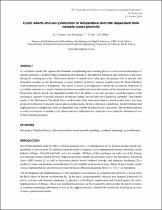 ResearchSpace
ResearchSpace
Cyclic effects and recrystallisation in temperature and rate dependent state variable based plasticity
JavaScript is disabled for your browser. Some features of this site may not work without it.
- ResearchSpace
- →
- Research Publications/Outputs
- →
- Conference Publications
- →
- View Item
| dc.contributor.author |
Jansen van Rensburg, Gerhardus J

|
|
| dc.contributor.author |
Kok, S

|
|
| dc.contributor.author |
Wilke, DN

|
|
| dc.date.accessioned | 2017-12-13T12:53:51Z | |
| dc.date.available | 2017-12-13T12:53:51Z | |
| dc.date.issued | 2016-10 | |
| dc.identifier.citation | Jansen van Rensburg, G.J., Kok, S. and Wilke, D.N. 2016. Cyclic effects and recrystallisation in temperature and rate dependent state variable based plasticity. 10th South African Conference on Computational and Applied Mechanics, Potchefstroom, 3-5 October 2016 | en_US |
| dc.identifier.isbn | 978-1-5108-3669-3 | |
| dc.identifier.uri | http://www.proceedings.com/33663.html | |
| dc.identifier.uri | http://toc.proceedings.com/33663webtoc.pdf | |
| dc.identifier.uri | http://hdl.handle.net/10204/9851 | |
| dc.description | Paper presented at 10th South African Conference on Computational and Applied Mechanics, Potchefstroom, 3-5 October 2016 | en_US |
| dc.description.abstract | A constitutive model that captures the dominant strengthening and softening physics or microstructural changes of metallic materials is needed within a numerical environment for the effective prediction and simulation of plasticity during hot working processes. Dislocation density or related stress values play the primary role of internal state dependent variables in the development of many unified constitutive material models using the Kocks-Mecking work hardening theory as foundation. This theory is based on an approach to model the viscoplastic behaviour of crystalline materials as a result of interaction between mobile and forest dislocations in the material microstructure. Dislocation density based state dependent models have the ability to not only provide a good description of the mechanical response of metallic materials in uniform loading, but also have good predictive capability. One popular model is the Mechanical Threshold Stress model while other dislocation kinetics based models have also been proposed in literature to include various physical phenomena. In this conference contribution, the development and implementation of temperature and rate dependent state variable based plasticity is presented. The model foundation as well as extensions to include cyclic effects and recrystallisation are coded into a user material subroutine for use in finite element packages. | en_US |
| dc.language.iso | en | en_US |
| dc.publisher | Curran Associates | en_US |
| dc.relation.ispartofseries | Worklist;19917 | |
| dc.subject | Mechanical Threshold Stress | en_US |
| dc.subject | Dislocation density based material modelling | en_US |
| dc.subject | Combined hardening | en_US |
| dc.subject | Recrystallisation | en_US |
| dc.title | Cyclic effects and recrystallisation in temperature and rate dependent state variable based plasticity | en_US |
| dc.type | Conference Presentation | en_US |
| dc.identifier.apacitation | Jansen van Rensburg, G. J., Kok, S., & Wilke, D. (2016). Cyclic effects and recrystallisation in temperature and rate dependent state variable based plasticity. Curran Associates. http://hdl.handle.net/10204/9851 | en_ZA |
| dc.identifier.chicagocitation | Jansen van Rensburg, Gerhardus J, S Kok, and DN Wilke. "Cyclic effects and recrystallisation in temperature and rate dependent state variable based plasticity." (2016): http://hdl.handle.net/10204/9851 | en_ZA |
| dc.identifier.vancouvercitation | Jansen van Rensburg GJ, Kok S, Wilke D, Cyclic effects and recrystallisation in temperature and rate dependent state variable based plasticity; Curran Associates; 2016. http://hdl.handle.net/10204/9851 . | en_ZA |
| dc.identifier.ris | TY - Conference Presentation AU - Jansen van Rensburg, Gerhardus J AU - Kok, S AU - Wilke, DN AB - A constitutive model that captures the dominant strengthening and softening physics or microstructural changes of metallic materials is needed within a numerical environment for the effective prediction and simulation of plasticity during hot working processes. Dislocation density or related stress values play the primary role of internal state dependent variables in the development of many unified constitutive material models using the Kocks-Mecking work hardening theory as foundation. This theory is based on an approach to model the viscoplastic behaviour of crystalline materials as a result of interaction between mobile and forest dislocations in the material microstructure. Dislocation density based state dependent models have the ability to not only provide a good description of the mechanical response of metallic materials in uniform loading, but also have good predictive capability. One popular model is the Mechanical Threshold Stress model while other dislocation kinetics based models have also been proposed in literature to include various physical phenomena. In this conference contribution, the development and implementation of temperature and rate dependent state variable based plasticity is presented. The model foundation as well as extensions to include cyclic effects and recrystallisation are coded into a user material subroutine for use in finite element packages. DA - 2016-10 DB - ResearchSpace DP - CSIR KW - Mechanical Threshold Stress KW - Dislocation density based material modelling KW - Combined hardening KW - Recrystallisation LK - https://researchspace.csir.co.za PY - 2016 SM - 978-1-5108-3669-3 T1 - Cyclic effects and recrystallisation in temperature and rate dependent state variable based plasticity TI - Cyclic effects and recrystallisation in temperature and rate dependent state variable based plasticity UR - http://hdl.handle.net/10204/9851 ER - | en_ZA |





